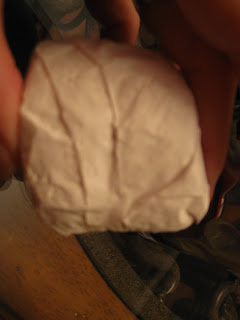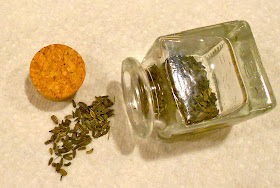Nothing on this earth can compare to the aroma of honey. Sweet and heady with a slight spicy note, it fills the air in the apiary come August. The combs are full of ripe nectar, capped and prepared for winter when the honey bees will tap into this sustaining liquid gold.
My harvest was small this year, only four combs, but the honey was dark and rich late season nectar flow from blackberry and knotweed. Because I keep Top Bar hives the comb is cut from the bars using a sharp knife leaving behind a wax "guide" for the new combs that will be built this coming spring. Any errant combs veering from a straight path will be cleaned up as to avoid any cross combing when the building begins again.
With natural comb the crush and strain method is used unless you are using a Langstroth hive (the typical square box hive) with the foundationless method where instead of using pre-formed wax foundation sheets you allow the bees to fill in the frames with natural comb. In this case you can still use an extractor which uses centrifugal force to spin the honey out of it's cells.
The capped honey is referred to as "ripe". The uncapped cells are in the process of dehumidification to around 17- 18% which the bees know and then cap the cell to prevent the honey from absorbing any more moisture. Unripe honey will ferment essentially becoming mead. The worker bees will keep the hive around 92 degrees by flapping there wings, this warm air movement dries out the honey and once it reaches the perfect stage the cell is capped. Honey is hygroscopic so it is important to store honey in airtight containers so that it will not absorb the moisture in the air. If you find your honey crystallizing this is what is happening. You can bring your honey back to a liquid form by gently heating it but this will destroy many of it's inherent beneficial properties. The best thing to do with your crystallized honey is to make Creamed Honey with it.
Creamed Honey recipe:
3 cups liquid honey
1/3 cup crystallized honey
Use an electric mixer to combine the two honeys completely until the mixture has no tongue detectable crystals. Bottle the honey immediately in a one piece lidded jar (not a cap and ring), place the jar upside down for two hours to allow any trapped air to rise to the bottom of the jar. Then flip the jar over and one large air bubble will rise to the top of the jar leaving your creamed honey with a smooth surface. Now store the jar in in a cool room (55 degrees) undisturbed for one week or until the honey has solidified. Tilt the jar a little, if the honey moves it is not set. It is possible to make flavored creamed honey as well using fruit, herbs, and spices. How about jalapeno, rosemary, or lemon? Just be careful not to bring the moisture level of the honey above 18%. Using powders or freeze dried fruits (powdered) will keep you safe without resorting to a refractometer.
Creamed honey is a wonderful spread for muffins, toast, or meats!
The crush and strain method is just what it sounds like. Place a large colander over a deep bowl or food grade bucket and crush the comb with a potato masher. The honey will drain through the colander slowly. I stirred the mixture a few times to help the process along. After an hour all that remained was the wax.
To process the wax I used a simple water method. I placed extra comb and crushed comb into a large aluminum pot then poured near boiling water over the top to cover and float the wax. I then heated the pot to near boiling so the wax separated from the cocoons and the cocoons started to float. And here I will divert into a side note for those of you wondering about the cocoons. When the queen lays an egg into a cell it develops into a larvae which in turns spins a cocoon as it goes through metamorphosis, similarly to a butterfly. When the baby bee emerges it leaves behind on the cell wall it's cocoon. The nurse bee then cleans and polishes the cocoon lined cell with wax and a piece of propolis. This ensures the cell is now sanitary for the next egg. There may be hundreds of eggs laid in that cell per rearing season. Once rearing is done most of these cells are filled with honey or pollen for winter stores. This is why new comb is pure white and old comb is dark brown. It is essential for the health of the colony for the beekeeper to rotate out the brood comb regularly as the cells become smaller and smaller. Old comb also creates an invitation to the wax moth larvae who thrive on old comb. In the wild the wax moth is natures way of ridding feral hives of old comb as the larvae cannot digest new comb but a managed hive should try it's best to be wax moth free. So to get the nice white comb back the wax needs to be rendered from the cocoons and other contaminates.
Stirring the wax/water mixture insures that all the wax is melted. Then the mixture is poured through a sieve or mesh screen into a clean bucket. The cocoons are left in the sieve, the water and wax are in the bucket. I let this cool and then lifted the now solidified round disk of wax off the water. This process can be repeated using finer and finer filters to further clean the wax.
I wanted to try preserving some comb honey as well. I cut out two small squares of capped honey and then poured some liquid honey over that. I think it looks rather pretty although a lighter colored honey say from maple nectar would make it much more dramatic. Maybe some decorative jars too? All comb honey should be put into the freezer to kill any wax moth larvae that may be present. If this step is skipped you might open up a jar to find little creatures a crawlin'! This is why taking comb honey from nice new white comb is best!
Honey is at it's best taken from a treatment free hive (no chemicals or antibiotics used to treat bee diseases and pests), non-filtered nor heat treated. Honey is naturally free from bad bacteria. It is anti-fungal, antibacterial, and a natural antibiotic. It is used for stomach ailments such as ulcers and is used on open wounds. It has been found to heal faster with less scaring on open wounds and acne. It has also been found that consuming local honey (never feed honey to children under the age of 1year) can lessen the effects of pollen allergies and build immunity.
Eat honey, my son, for it is good; honey from the comb is sweet to your taste. Proverbs 24:13



















































